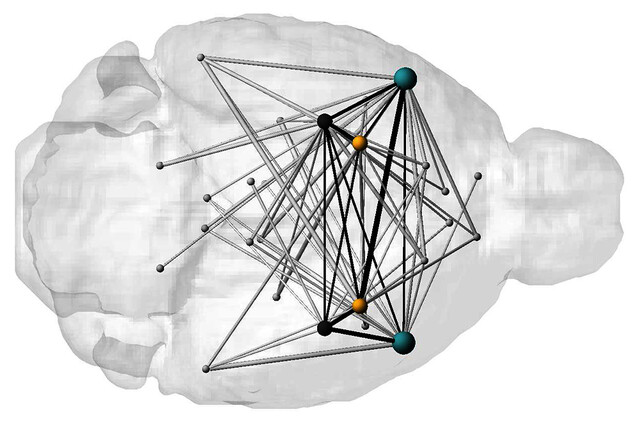Neural basis of gut feelings: insular cortex and amygdala tell good from bad
How do we learn whether to approach or avoid something? Using functional brain imaging in mice, scientists from the lab of Wulf Haubensak and collaborators discovered a neuronal loop between the brain regions insular cortex and amygdala, which tags a stimulus as good or bad. This network could underly intolerance to uncertainty.
Survival often depends on making the right decision on whether to approach or avoid something. Getting this right is often vital for behaviours such as securing food or evading a lethal threat. These so-called affective decisions must be rooted in mechanisms that allow the brain to assign a value to its environment. A classic example comes from Pavlovian conditioning, in which animals are trained to associate a stimulus such as a sound with a reward or punishment. In such a setting, the brain classifies this sound as either good or bad - and responds accordingly, even though there is no intrinsic value in incoming sensory information (the sound) per se. How the brain assigns a value to environmental stimuli is a fundamental question in behavioural neuroscience.
One possibility is that signals from the body are used for this purpose. These so-called interoceptive signals reflect how we ‘feel’. Interoceptive states during past experiences that were either rewarding or punishing - a thirst-quenching drink or a painful injury – may be used to guide affective behaviour in the future. But how does the brain link environmental stimuli and bodily well-being to guide behavioural decisions?
Scientists from the lab of Wulf Haubensak at the Research Institute of Molecular Pathology (IMP) and collaborators now resolved this question by combining tools from different disciplines. First, thirsty mice were trained to Pavlovian tones: while initially uncertain what the sounds meant, they learned one sound predicted a rewarding water drop and another a slight foot shock. Successful association then evoked either approach to the water or aversive freezing responses to the sounds, indicating that the initial uncertainty on sound value was resolved with learning.
Tools from a range of disciplines
To unravel the neural mechanism that governs this process, the scientists then used functional Magnetic Resonance Imaging (MRI) to monitor brain activity with a resolution down to only a few hundred neurons. This allowed them to map a dedicated neuronal network between the amygdala, the basal forebrain and a brain area sensing interoceptive signals, called the insular cortex.
The scientists then recorded signals from individual neurons and investigated the information flow between the two brain areas critical for emotional learning, the insula and amygdala. To analyse neuronal activity data, the Haubensak lab collaborated with colleagues at VRVis (Zentrum für Virtual Reality und Visualisierung). This allowed the decoding of how affective value is computed in the neuronal activity pattern of this network.
Initially, the brain does not know what to make of the novel sounds. The amygdala then tries to resolve this by sending signals to the basal forebrain. This, in turn, stimulates the insular cortex. As learning progresses, insular activity patterns related to sounds become more similar to interoceptive states reflecting punishment or reward. In this way, sounds are given a meaning, they start to ‘feel’ good or bad. This value information from the insular cortex is projected back to the amygdala where it guides the behavioural response. When the scientists blocked either signals of uncertainty or the interoceptive value from the insular cortex, the animals made the wrong behavioural decision more often.
Coping with uncertainty: clues for future research
The findings show that the interplay between insular cortex and amygdala assigns stimulus value from bodily signals and uses this to inform future behavioural decisions.
“Ultimately, this mechanism can explain how we listen to our body or gut feelings when making emotional decisions, particularly when we are not yet sure about how to rationally respond”, says Wulf Haubensak.
Neuronal networks such as the one described could play a role in an organism’s ability to resolve uncertainty. Faulty communication between amygdala and insular cortex might constrain the ability to behave under uncertainty. This could underly the low tolerance to ambiguous settings in psychiatric conditions such as anxiety disorders and autism, which opens new questions for future research.
Original Paper
Dominic Kargl, Joanna Kaczanowska, Sophia Ulonska, Florian Grössl, Lukasz Piszczek, Jelena Lazovic, Katja Bühler, Wulf Haubensak: “The amygdala instructs insular feedback for affective learning”. eLife, DOI: 10.7554/eLife.60336
***
About the Vienna BioCenter PhD Program
Joanna Kaczanowska and Dominic Kargl are equal co-first authors of this paper. They did the underlying research in the frame of the Vienna BioCenter PhD Program. Are you interested in a world-class career in molecular biology? Find out more: https://training.vbc.ac.at/
